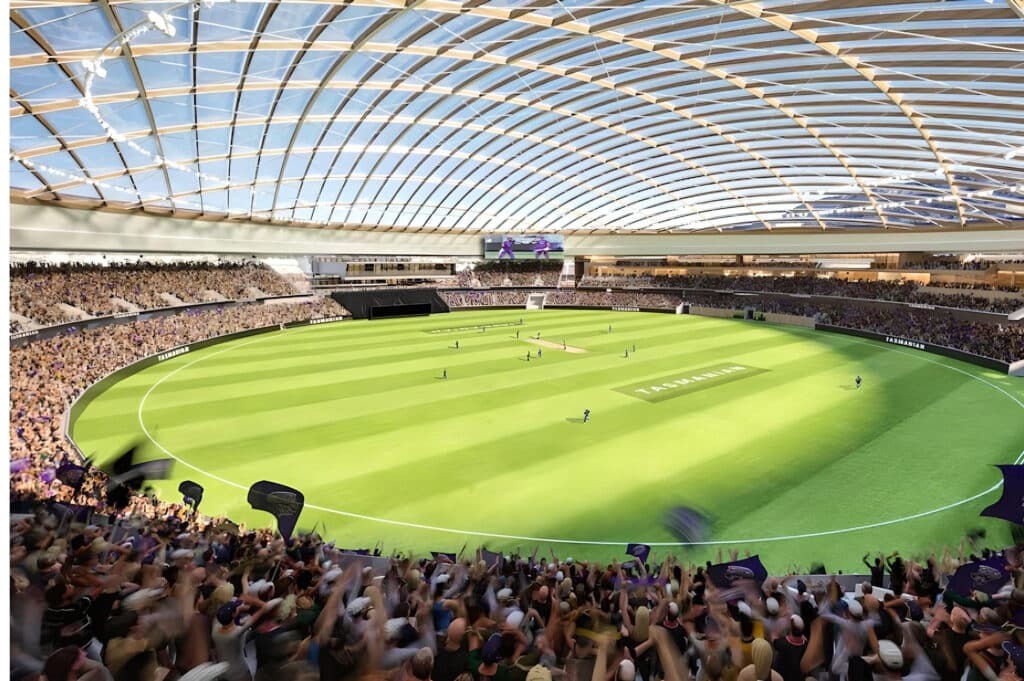It’s puffy, lightweight, durable, fully transparent, and keeps the UV away… now its being used to build the world’s first all-weather cricket stadium!
While ethylene tetrafluoroethylene (ETFE) sounds unusual, the material is now an integral part of new NFL stadium projects in Chicago, Nashville, and Buffalo—and was a centrepiece of the Las Vegas Raiders Allegiant Stadium, the host of this year’s Superbowl.
A key part of the $715m Macquarie Point proposal—dubbed the world’s largest timber-roofed stadium—Cox Architecture has combined ETFE’ UV protecting cushions’ with a hybrid steel glulam post-and-beam system.
“The carefully designed cutting-edge design includes a timber and steel framed fixed ETFE transparent roof, which will see Tasmania leading the world in structured timber roofing solutions,” according to Mac Point, who is responsible for overseeing the stadium, adding that the design is “quiet, clever, but humble, just like Tasmanians.”

These days, “If a building is going to have a roof on it in some way, it’s going to have ETFE on it somehow,” said Dan Wacker, Mortenson director of preconstruction, in an interview with the Sports Business Journal.
“It’s like a platform that you can innovate on,” said Populous principal and senior architect Phil Kolbo. “You’re not pulling things off the shelf anymore; you’re making what you need.”
Already used in Nike’s Hayward Field Stadium—the venue for the US Track and Field Olympic trials—and the Grand Palais Éphémère, which will host the Olympic wrestling and Judo later this month, ETFE, when combined with a hybrid timber system, can offer the best of both world’s for stadium executives: “That’s because the ETFE will allow light in, support natural turf growth and avoid the need for large light towers,” Nic Street, Tasmania’s Sports Minister told the media on Sunday.
Tensile membranes are lighter and cheaper than steel. They also allow controlled natural light into otherwise dim indoor stadiums and have an open-ended potential for use in all building parts—not just roofs but in instead of glass windows or as coverings over seating bowls.
“When you talk about the fan experience on open-air facilities, traditionally, NFL stadiums haven’t had canopy coverage,” said Mr Wacker. “But Europe is full of PTFE (a white waxy version of ETFE) roofs that shade the fans; MLS (American Soccer) is going for 100% coverage of its fans, and I think the NFL would look at teams using that as an option.”

One of the major strengths of tensile systems is that they can be stretched over two sides of anything – with flexibility allowing designers to incorporate complex curves and shaping that would be impossible, or at least very costly, with traditional steel and metal panel roofs:
“[Tensile fabrics] give architects and designers of sports stadiums a unique freedom of form and flexibility to take their design to the next level,” according to David Peragallo, sales and specification manager, Americas, at French firm Serge Ferrari Group.
TFE materials are also highly resistant to heat and sunlight abuse, are hydrophobic, and have a low coefficient of friction, meaning they’re easy to clean because nothing sticks to them. “ETFE is thinner than PTFE, allows natural light into a space and is better for fully enclosing and conditioning a building,” according to Sports Business Journal. Meanwhile, “PTFE is more effective for shading structures, like canopies, because it’s a mesh and not as transparent.”
“Tensile materials like ETFE are lighter than traditional roofs and need less support,” Mr Wacker said, “that’s critical for stadium project budgets because the long-span steel propping up a roof can run 600 to 800 feet in length and is the most expensive part of the stadium.” Who added that the cost of a fully steel-supported roof, especially if it mechanically retracts, is why so many NFL stadiums have opted not to build roofs.
Is ETFE and hybrid timber a solution for the Brisbane Olympics?
Last year, Wood Central revealed that a Design alliance led by Brisbane-based architecture firm Buchan Group, along with HKS and Nikken Sekkei—the two architectural practices behind the 2020 Tokyo and 2028 Los Angeles Olympic Stadiums—is pushing Game Organisers to build stadiums out of greener materials, including timber.
At the time, HKS Director Andrew Colling spoke of the potential for a revamped Gabba Stadium to feature a timber shell “with blended greenery and sandstone instead of a cookie-cutter concrete stadium.”
And whilst the choice of stadiums has been shrouded in controversy, an ETFE and hybrid timber canopy that either fully encloses the stadium or just acts as a skylight over the playing field (similar to Allegiant Stadium in the Nevada desert) could be an option for Brisbane to add some “wow factor” ahead of the games.
- To learn more about the Brisbane Olympic Games, the first to follow the International Olympic Committee’s (the IOC’s) new norms, visit Wood Central’s special feature.






